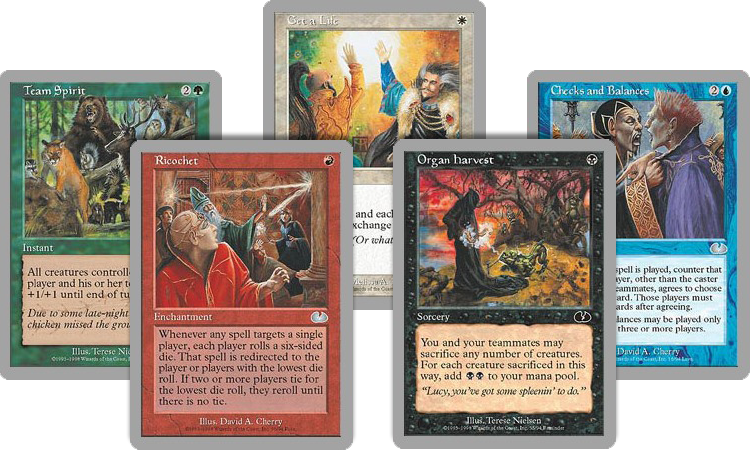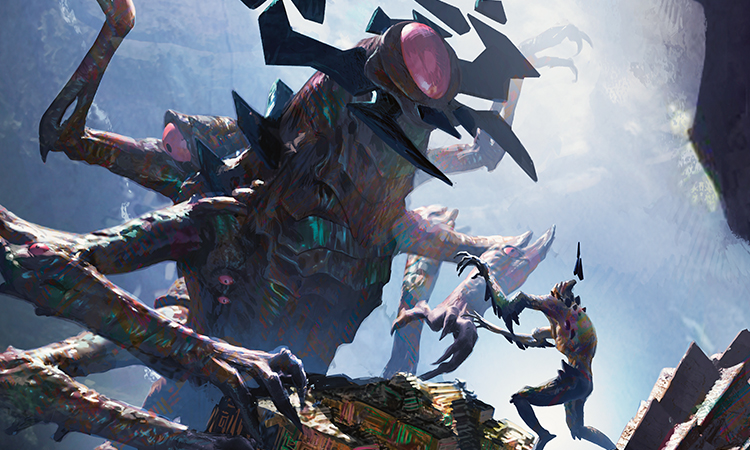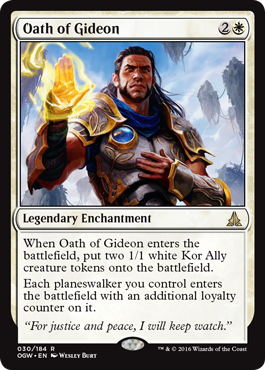A Solemn Oath, Part 2
When last we left our intrepid Oath of the Gatewatch design team , we learned that the second set in the Battle for Zendikar block had been built around Kozilek, an Eldrazi titan that everyone had assumed had left the plane of Zendikar. Instead, he had burrowed underground and was returning to the aid of his trapped fellow titan, Ulamog. The team came up with the idea of having Kozilek's reality-warping ability reflected by having colorless mana as a cost requirement. This resulted in us coming up with a new symbol for colorless mana as well as creating a new basic land, Wastes.

The problem was that the story was only partly about Kozilek. It was also the set where a collection of Planeswalkers were going to band together to form a team to fight threats like the Eldrazi. The design was on the hook for mechanically representing that aspect of the story as well, something the team didn't realize until halfway through the design. Today's story is about how the team accomplished this task.
Come Together
At the very next meeting (after the brand team asked us to highlight the new super group), Ethan came to the design team with our new goal. The set would still have the Kozilek stuff, but in addition, we needed to have some mechanical elements that communicated the forming of the Gatewatch. We did some brainstorming to figure out what that might mean:
- Mechanics that involved cooperation between players
- Mechanics that rewarded combinations
- Mechanics that built things up
- Mechanics that allowed creatures to help one another
The common bond we found was twofold. First, we liked the idea that some group of things, be it players or creatures, created a beneficial relationship with each other. Second, we saw coming together as a team as being symbolically represented by building up and becoming stronger. These were the threads we started with.
A Surge in the Polls
A very common thing to do when using a brainstorm to come up with new mechanics in design is to start with some of the more "out there" suggestions. Going down paths you've trod numerous times will only result in you remaking mechanics you've already made, but starting somewhere fresh allows you to explore places that perhaps you've never visited before.
Because of this, the first idea we explored was that of a mechanic that helped you help another player. Many years ago, Unglued was the first Magic set to ever play in this space, with a cycle of five cards that acknowledged players other than your single opponent.

Magic is a multiplayer game, but we've always worded black-border cards so that they made sense in a two-player game. As such, we've avoided putting words like "teammate" in rules text. But this was going to be a set all about a team coming together. Maybe we could bend the rules here to reinforce this theme.
The problem, of course, was that we didn't want to print cards in black borders that were meaningless in two-player play. So how could we care about teammates in a way that mattered and was relevant but didn't render the card obsolete in a traditional two-person duel?
The solution to this problem was to find a way to care about something that teammates could help with but that didn't necessarily require them. What exactly fit that description? After some talk, it was clear that one of the easiest things to care about was spells being cast. It's something that other players do that you also do. Ari suggested a card that somehow cared if a spell had been previously played this turn. It could be a spell you played or it could be a spell that a teammate played. Interestingly, this mechanic—minus the teammate part—was something we explored during Odyssey design many years ago. (Ari was unaware of this; the more design I do, the more I observe parallel designs where two different people/groups end up with the same design.)
The big question was how exactly the spell was affected by having another spell previously cast. We toyed around with the idea that it enhanced the spell, either making it have a bigger effect or possibly having a second synergistic effect. In the end, we decided that it was more important to make sure you could cast it. After all, in a two-player game, you had to have cast another spell—and thus didn't have a lot of mana. This led us to decide to make the benefit a reduced cost.
Surge was a little controversial because of the inclusion of the word "teammate" in the ability's reminder text. The design team's stance was this: Part of making sets have an identity is finding places to push in directions we don't normally go. Yes, we didn't want to start using the word "teammate" in every set, but in the set all about a team being formed, we felt it was an acceptable bend. We stressed to the development team that the mechanic still worked if you took off the teammate part, so they would have the ability to test it, and if they found the "teammate" inclusion too problematic, it would be easy to remove it later.
Another side effect of including this mechanic was we decided it would be fun thematically to push the Two-Headed Giant format with the release of the Oath of the Gatewatch. We don't often have a mechanic like surge that calls out teammates, so as part of the larger theme we were working for, we suggested Organized Play support some Two-Headed Giant play. As such, both design and development playtested the set in the Two-Headed Giant format, something we don't normally do.
I'm happy to say that when the dust settled, it was decided that design's instincts were correct and the teammate component stayed as part of the surge mechanic.
Thank You for Your Support
The next place we started exploring was the idea of your creatures helping out one another. It was quickly pointed out that the Gatewatch was a collection of Planeswalkers, so maybe we could also find a way to help out planeswalkers. We knew that just helping out planeswalkers wasn't something we'd do at common, and we were interested in finding a mechanic we could use at common—which meant we also wanted to help out creatures.

Art by Kieran Yanner
We started with the idea of figuring out how a player could help both creatures and/or planeswalkers. We realized that the help fell into a couple categories:
- You could help make it easier to get creatures/planeswalkers onto the battlefield
- You could make creatures/planeswalkers more powerful on the battlefield
- You could protect creatures/planeswalkers, making it harder for opponents to get rid of them
Surge was already an alternate-cost mechanic, so the first option wasn't something we were interested in. We also felt that the third felt more indirect than the second, as preventing harm wasn't as clean and clear as helping. The new question was, how could we help both creatures and planeswalkers? Planeswalkers were a more complex problem, so we started there. Planeswalkers on the battlefield mostly cared about loyalty. The obvious way to help them would be to grant them extra loyalty. The problem, though, was that creatures don't have loyalty.
We took a step back and thought about loyalty more abstractly. Planeswalkers have a resource represented by a counter. Creatures could also do that through the use of things like +1/+1 counters. We've learned through the proliferate mechanic that we can tie +1/+1 counters and loyalty together by caring about counters. Since we were interested in the flavor of helping out one another, perhaps the mechanic could add counters—loyalty counters for planeswalkers and +1/+1 counters for creatures.
We explored different options, but in the end decided to make it a keyword action. This action was something you could do, as a spell, as an "enter the battlefield" effect, wherever we felt it made the most flavor sense and played the best. As we were trying to create a sense of teamwork (support was originally called teamwork), we liked the idea that if you got to distribute more than one counter, you had spread it around to multiple creatures and planeswalkers. This way you wouldn't just stack everything on one creature but rather build up your whole team.
The mechanic passed from design to development, and for most of development all was well. Late in the process, though, it became clear that putting loyalty counters on planeswalkers created a number of developmental problems. It was so late in the process that there wasn't time to do extensive reworking of the mechanic, so unfortunately the only option was to remove the loyalty-granting part of the ability. Luckily, the change had very little impact on Limited, where the mechanic was made to shine.
Interlude: More Changes to the Status Quo
Before I can continue on with my story, I must first explain another curveball thrown to the Oath of the Gatewatch design team. (If I haven't made it crystal clear, the design team had a lot more issues to deal with than an average small-set design team.) Magic is currently 22 years old, and as such has a certain rhythm of how things work. Since Magic Origins, we have been making major changes to break that rhythm and try different things. Rather than one block a year, we're doing two. Instead of three sets in a block, there's two. Core sets are gone. We've doubled down on our story and have created whole new ways to tell it and express it through the cards. Well, once you start making changes as big as these, you're open to making other big changes.
What is the number one most common request we've gotten about small sets over the years? Any ideas? The answer is that players really want to play more of it when the set comes out. We've altered how many packs you play with at the Prerelease, but the audience wanted something more substantial. Why couldn't drafts with a small set have two packs of the small set and just one of the large set? Why can't drafting have more of the new cards in it?

Skitterskin | Art by Michael Komarck
For years we've ignored this suggestion, because we believed that the smaller card pool would lead to a less robust drafting experience. But in the spirit of change, we decided to finally question our assumptions. Instead of asking "Should we do this?" we asked instead, "What would we need to change if we did do this?" The Oath of the Gatewatch design and development teams spent time on this problem and then came up with a number of suggestions for how to do it correctly. One of those suggestions was to increase the set size. Another was being a bit more proactive about making sure that the newer set evolved how certain block elements played. This latter decision will become important in a moment. Happily, we think we figured it out—and moving forward, small sets will draft Small Set/Small Set/Large Set.
Finding Cohorts
The design team was trying to be more proactive about changing up block elements. The Ulamog-flavored mechanics were giving way to the Kozilek mechanics, so the Eldrazi side was having a fundamental shift. That meant the design team had to do the same for the Zendikari side. The plan to do this was to introduce a new Ally keyword mechanic.
The design team experimented with numerous different designs, but ended up with something we called breakthrough. Breakthrough was a mechanic that said, "At the end of combat, if any of your Allies dealt combat damage to an opponent, TRIGGER EFFECT." The mechanic aimed to show the Allies becoming aggressive in trying to stop the Eldrazi, and so shifted to a more combat-centric focus.
The mechanic made it to development, but it was there that it was decided the mechanic too heavily pushed all-out aggression. The Allies in Battle for Zendikar had also been pretty aggressive, and there was interest in coming up with an Ally mechanic that might shift the Ally strategy in a new direction, away from just being aggressive. As is often done in development when there is a need for a new design, a mini team was put together. This team was run by Ethan Fleischer and their goal was to find a mechanic that pushed Allies in a new direction.
The team came up with a number of different options, but the one the development team liked most was cohort. Cohort is an ability word on creatures that requires tapping that creature and another Ally. The mechanic was based on designs from Onslaught that required tapping a certain number of a particular creature type.
The idea behind the mechanic was that it represented the Allies working together, and it had a bit more of a combo feeling that encouraged building up rather than all-out aggro. Also, as each effect could be different, it allowed for the mechanic to support various strategies.
Interestingly, the one big sticking point with the mechanic was trying to choose how to best represent it. The original design copied the Onslaught cards and just said, "Tap two Allies you control." The concern was that many players might not understand whether you could use cohort to tap a creature on the turn you cast it. (Yes, you can, but only for a different Ally's cohort ability; summoning sickness prevents using a tap symbol, but not tapping a permanent as a cost.) The editing team and development tried various different versions and finally settled on the version where it's a tap ability and requires the tapping of one other Ally.
Making an Oath
The final piece to the puzzle was my biggest contribution to the set. We were talking about capturing a team coming together, and I flashed back to a comic from my youth: the Justice League. The Justice League is the biggest superhero group from the DC Comics universe and has over the years included all the major superheroes from that comic line: Superman, Batman, Wonder Woman, Flash, Green Lantern, and more. I was a huge Justice League fan growing up, and I went out of my way to read all the early issues of the comic.
The original team started with seven members, and then every once in a while the team would add a new member. Whenever a new member was added, the comic would most often end with them taking an oath to uphold the principles of the team. I liked the imagery and thought having our characters take an oath would be a nice visual. Mechanically, I thought we could make a cycle of Oath cards that would represent who exactly was joining the team. This would also help in the future as other Planeswalkers joined the Gatewatch.
The question was how we could mechanically represent the Oaths. I knew we wanted the names to be "Oath of PLANESWALKER," which implied to me they'd be enchantments, as it felt like something permanent. We gave each Oath a good enters-the-battlefield effect to make sure they would be worth playing, and then we granted each one a static ability that would be beneficial to any other planeswalkers you had.
In our original version, we had the static ability grant all your planeswalkers a new loyalty ability, but development pointed out that this would make all planeswalkers more similar and would create repetitive gameplay. Also, they would be hard to balance, and if we wanted the ability to make many Oaths in the future, it would leave limited design space. In the end, it was decided to go a little broader with the static ability and have it help planeswalkers in different ways. The cycle, by the way, is actually not a full cycle, as there are only four colors represented. There was no black-aligned planeswalker interested in joining the Gatewatch. (Ob Nixilis being the only candidate on Zendikar, and he's not really a team player.)
The one last change made by development was making the Oaths legendary, both to allow them to push the cards a little power-wise and to keep from having too many of them clogging up the battlefield. And now I give you Oath of Gideon:

That's all I have for today. As always, I'm eager to hear any feedback on either my column or the new set. You can send me an email or contact me through any of my social media accounts (Twitter, Tumblr, Google+, and Instagram).
Join me next week when I start telling some card-by-card stories about the set.
Until then, may you find some people who you can team up with.
"Drive to Work #292—Dragons of Tarkir, Part 4"
This podcast is part four of my six-part series on the design of Dragons of Tarkir.
"Drive to Work #293—Dragons of Tarkir, Part 5"
This podcast is part five of my six-part series on the design of Dragons of Tarkir.
- Episode 293 Dragons of Tarkir, Part 5 (15.5 MB)
- Episode 292 Dragons of Tarkir, Part 4 (18.2 MB)
- Episode 291 Live Life Like a Gamer (14.9 MB)
- Episode 290 Dragons of Tarkir, Part 3 (26.8 MB)
- Episode 289 Dragons of Tarkir, Part 2 (20.5 MB)

